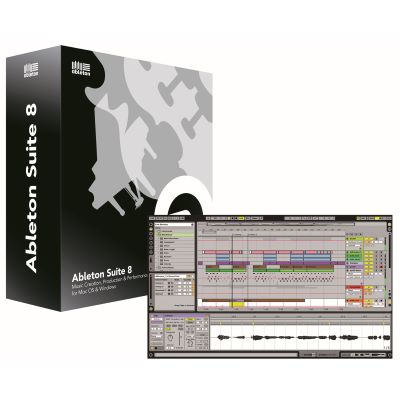

The audio file warping and grooving machinery has been given something of an overhaul in Live 8.

#Ableton suite 8 upgrade#
It's tempting to feel a bit swindled - a major, paid‑for upgrade and it all looks the same? - but the improvements are non‑trivial, and the lack of upheaval to one's working process is actually a plus point. I'm running both versions here, and found myself launching the wrong one by accident a few times and taking a minute or two to actually notice. Thankfully, Live 8 looks and works almost identically to Live 7. Arguably this doesn't matter much - who cares what instruments are used so long as the result is good? - but it's potentially tricky to share projects with other users if you aren't sure what instrument packs they own and which ones you are using.

All the instruments and sample sets occupy the same hierarchical navigation tree, and it's not immediately clear which instruments are part of which Live Packs: for example, some presets contain layers that mix samples with physically modelled synthesizers.
#Ableton suite 8 full#
The full set of Live Packs occupies 48GB of disk space when unpacked, and installation on my MacBook Pro took several hours. The sample libraries are packaged as 'Live Packs' - compressed archives which Live itself unpacks and installs - so you have some choice as to what you want to install.
#Ableton suite 8 software#
This is a four‑DVD boxed set consisting of Live 8 itself, a core library of samples and presets, the full set of Ableton's software instruments, a collection of loops and samples from Cycling 74 and Zero‑G, a library of Latin Percussion instruments and samples, version 2 of the Essential Instruments Collection (EIC), and two DVDs dedicated to session drums. I reviewed the full Live 8 package, called Ableton Suite 8. Does it still hold itself together in version 8? Eight Piece Suite Despite a major version release once a year, Live has already made it to version 7 without compromising its clean design and solid reliability. But this elegance of design tends to fly in the face of the software industry, where an arms race pushes vendors to add more and more features to their products to win on press release bullet points. Thirdly, Live's interface is clear and simple: one window, two views, and fixed panels for instruments and sample browsing.Ĭombining sophistication with ease of use is incredibly difficult, but Live manages to do so, with an interface that promotes flexible working without clutter or distraction. Secondly, it implements a number of powerful and versatile features in a clean and reliable manner: instruments and drums can be 'racked' and chained in infinite combinations, audio can be routed and mixed in ways an actual mixing desk can only dream of, and the automation support is obsessively thorough and rock solid. Firstly, it knows about looping, and works very hard at cueing, synchronising and aligning looped material, and providing a sophisticated editing interface for loop‑based music. Live's remarkable success comes down to some simple but well‑considered design choices. Live has always been something of a two‑headed beast - a loop‑based performance instrument on the one hand, and a linear recording and production platform on the other - and with the arrival of MIDI sequence support, opening the door to VST Instrument and effect hosting, Live became a serious contender as a studio production platform, while still enjoying a position on practically every performer's laptop on the planet. The landscape eight years ago was dominated by well‑established, complex linear sequencing packages that were geared towards multitrack studio recording and production, but the newcomer quickly gained popularity by aiming at a slightly different part of the market: live performers and DJs. Since its arrival on the audio software scene in 2001, Ableton Live has carved out a niche as a hugely popular music production and performance tool. The challenge was to add yet more features to Live without compromising its legendary ease of use.


 0 kommentar(er)
0 kommentar(er)
